
from Sehinggit Media https://ift.tt/2mxtdYw
via Merah Hati Cintaku
from Merah Hati Cintaku https://ift.tt/2msX7wU
via merahhaticintaku.blogspot.my


Here’s the copycat recipe for the wildly popular Pon de Ring donut from Mr. Donut in Japan! They are soft, airy, bouncy, and chewy all at the same time! It’s hard not to take a second look at these playful looking donuts, but what makes these babies a standout is its unique mochi-like texture. What’s your choice: classic glaze? matcha glaze? I’d say both.

When we talk about Japanese donuts, Pon de Ring Donuts (ポンデリング) from Mr. Donuts instantly comes top in my mind. Have you seen them before? Yeah, I’m talking about these slightly quirky, ‘baby teething ring’ looking donuts that hit the sweet spot when snack time is calling.
Besides the funky outlook, Pon de Ring Donuts have a unique chewy (we call it the mochi-mochi) texture that set them apart from the regular donuts. I will say that they are GOOD. And dangerous. My family is crazy about these donuts whenever we’re in Japan, so I’ve challenged myself to make them at home!
Pon de Ring (ポンデリング) is a Mister Donut’s signature donut in Japan, which is made of a connected circle of 8 dough balls. The name Pon de loosely came from Pao de Queijo, a popular savory Brazillian cheese ball made of tapioca flour.
In case you’re not familiar with Mister Donut, it is the largest donut chain in Japan with over 1,300 stores and across Asian countries such as Taiwan, South Korea, and Thailand. What’s really interesting is Mister Donuts originated from the US and opened their first store in Osaka in 1971. While Japan’s Mister Donuts was expanding over the past four decades, almost all the Mister Donuts in the US changed their name over to Dunkin Donuts due to mergers and acquisitions.

You can find the classic Pon de Ring flavors (below) at almost every single Mister Donut in Japan and they also release many seasonal and unique flavors:
If you’re curious about all the current and past donut flavors at Mister Donut, you can check out this official page (it’s in Japanese, but use Chrome to translate).

Some of you may be wondering if Pon de Ring is (or is similar to) Mochi Donut. But I have to tell you Pon de Ring is NOT Mochi Donut and here’s why.
Pon de Ring
Mochi Donut
As you can see, the ingredients and texture of these two donuts are very different. If you have tried Pon de Ring in Japan, you would be able to tell them apart. Even though some of the mochi donuts might look like a copycat of Pon de Ring.
In Japanese, we describe Pon de Ring’s mochi-like texture as mochi-mochi (モチモチしてる) or mocchiri (モッチリしている) texture, but it does not always mean that the food being described is made of mochi. For example, bagels with a chewy texture can be described as it has a mochi-like texture.
If you have tried and loved the texture of mochi donuts, check out Mandy’s website, Lady and Pups for the recipe. I’ve made it before and they were excellent.

Mr. JOC and I spent 2 weeks figuring out the Pon de Ring recipe, sometimes making donuts several times a day! Our focus from the beginning was to achieve the right airy but mochi-like texture of Pon de Ring. If we can’t make it the same due to lack of machinery or unnatural ingredients, we wanted to at least achieve the best possible quality.
We started by working out the main ingredients – specifically flours. We tried the following flours in chronological order:

In the YouTube video I mentioned earlier, you can see Mister Donut’s Pon de Ring dough is quite sticky and soft when kneading.
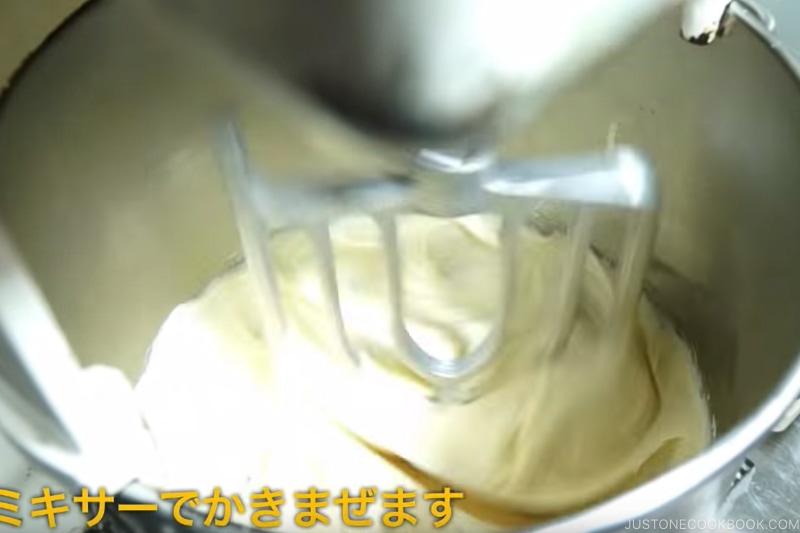
And the final stage of the dough (see below) is still pretty sticky and soft.

Mister Donut does not need to shape the dough into Pon de Ring shape by hands. The machine squeezes out the dough to create its funky ring shape and shot directly into the hot oil. Obviously, I don’t have that machine in the kitchen and subject to shaping the sticky dough with my hands.

I tested all-purpose flour and tapioca flour ratios to see if I can achieve the dough that’s easier to deal with. However, the ratio for tapioca flour needs to be higher and it yields a pretty soft dough. When you increase the flours, the final texture of the donuts become denser and cakey. So I just learned to deal with the soft and sticky dough and figured out some tricks to shape the connected bubbles ring of the donuts.

To achieve the perfectly airy, and mochi-like texture for the Pon de Ring donuts, I’ve partnered with Bob’s Red Mill® and used their Tapioca Flour and All-Purpose Flour.
When comes to baking and flour products, I highly recommend Bob’s Red Mill. The quality of the flours is unbeatable and I genuinely admire the company for their honest ingredients and the processes used in producing the products.
You should be able to find these flours at any major grocery stores. Alternatively, you can also buy on Amazon (Tapioca and AP Flour).

The two most common dry yeasts are Instant (Quick/Rapid-Rise) Yeast and Active Dry Yeast. You can read this detailed information about different types of yeasts.
The major difference is that active dry yeast always needs to be dissolved in warm liquids (water or milk) before using while instant yeast can be mixed right into the dough. For convenience, I like using Instant Yeast.
The two popular instant yeast brands are Red Star and Fleischmann’s and you can find them at grocery stores. I have tried both brands before, and for this recipe, I used Red Star Quick-Rise instant yeast to make my donuts.
After reading this page on instant yeast, I’ve decided to hydrate/dissolve my instant yeast (even though it’s not active dry yeast) in warm milk (110 ºF or 43 ºC – slightly warmer than body temperature) to give it a good start. It allows the yeast to become very active and ready to work in my dough.

From Mister Donut website and other public articles online, we learned that their donuts are deep-fried in lard, and possibly a combination of other oils such as vegetable shortening. They are both saturated fats that stay solid at room temperature, which allows the donuts to stay crisp and not “wet” after deep frying.
As I wanted to avoid lard or vegetable shortening, we tried deep frying the donuts in our go-to oils for its neutral flavor and high smoke point – vegetable oil and canola oil. However, we did not like the vegetable oil taste that’s been left on the donuts.
After reading this article, we gave safflower oil a try and we agreed that it’s the best oil for frying donuts.

To work with the sticky dough, I learned that this thin plastic pastry card (shown above) became very handy! If I was only using my fingertips, the dough sticks and grows spike tips everywhere I touch and loses its round shape.
This pastry card also helps to divide, scrape, and transfer the mini dough balls, and I didn’t let go from my right hand (except for the time when I was rolling the dough ball with my palms).

After deep-frying Japanese croquettes, Chicken Karaage, and Tempura for over 20 years at home, I can deep-fry comfortably without a thermometer.
On the contrary, Mr. JOC loves “high tech” gadgets, and set up my deep frying station with our Thermaworks ChefAlarm. I started deep frying and noticed that ChefAlarm warns me when the oil temperature exceeds the low and high temperatures. I didn’t realize how super convenient and helpful it was until I got busy juggling deep-frying and glazing the hot donuts at the same time.

For the donut fans and baking aficionados out there, I hope you would try your hand at Pon de Ring. The donut making was no doubt an endeavor, but we were glad that we perfected the recipe and the reward paid off. Otherwise, add the Pon de Ring donuts to your list of must-eats when you visit Japan.

Japanese Ingredient Substitution: If you want to look for substitutes for Japanese condiments and ingredients, click here.
Sign up for the free Just One Cookbook newsletter delivered to your inbox! And stay in touch with me on Facebook, Pinterest, YouTube, and Instagram for all the latest updates.

Here’s the copycat recipe for the popular Pon de Ring donut from Mr. Donut in Japan! They are soft, airy, bouncy, and chewy all at the same time! The mochi-like texture is unique and different from traditional donuts. Enjoy them with classic glaze or matcha glaze.
Gather all the ingredients and measure everything ahead of time. I've used a kitchen scale to measure my flours. Prepare 24 sheets of 4” x 4” (10 x 10 cm) parchment paper.


In the bowl of a stand mixer (or a large mixing bowl), combine whole milk (110 ºF or 43 ºC – slightly warmer than body temperature) and instant yeast, and then add ½ tsp sugar from the 50 g (¼ cup) sugar you prepared. Whisk the mixture well. Set aside for 5-10 minutes. NOTE: If you wonder why I hydrated instant yeast (even though it’s not Active Dry Yeast), please read the post.

Prepare a large mixing bowl and sift the tapioca flour and all-purpose flour through a fine-mesh sieve. Whisk to combine.

Set the stand mixer with a flat beater attachment. Add the rest of the sugar and beaten egg to the milk mixture.

Add the melted butter and vanilla.

Beat on low speed for 1 minute until combined (Or, stir with a wooden spoon).

Add roughly 2 cups flour mixture and beat on low speed until well combined.

With the stand mixer running on low speed, add the remaining flour mixture one scoop at a time and salt. By the way, keep the mixing bowl that flours were in. We’ll use it after this step). The dough mixture has thickened.

Now change to medium-high speed (Speed 6) and beat for 3-4 minutes, or until smooth and elastic. Note that this is a sticky dough, so do not add additional flours. Tip: Kneading develops the structure of the dough by folding and stretching strands of gluten. Hand Kneading: Because of the nature of this dough, it’s hard to knead the dough by hand. You can add 1-2 tablespoons of flour if it’s too wet to handle, but do not add any more flour than that. Hand-knead for 5-6 minutes.

Now bring back the large mixing bowl (that has flours in it earlier). Add a little bit of oil and grease it with a paper towel.

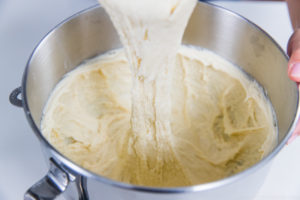
Using the pastry card, transfer the dough into the greased bowl. Try to scrape down the dough from the sides, collect the dough into one big mass, then gently scrape it down to the greased bowl. The key here is to make sure the surface of the dough is mostly smooth (so that it will rise nicely). Loosely cover the bowl with plastic wrap (or a shower cap) and place it in a warm environment to rise until doubled, about 70-80 minutes. I use my “Proof” oven setting at 100 ºF (38 ºC). I put warm/hot water (away from the dough) to keep the inside of the oven moist. Tip: Make sure the proof temperature is not too high. If the dough gets too warm, it will ferment too quickly (or over ferment) and impair the flavor.

After 70-80 minutes, pour the oil into the Dutch oven. If you have a thermometer, set up. I used Thermowork’s ChefAlarm. A probe clip attaches the probe right to the side of the dutch oven holding it securely in place, keeping it from flopping it around. Set your alarm thermometer to 325 ºF (168 ºC) as the lowest and 350 ºF (177 ºC) as the highest.
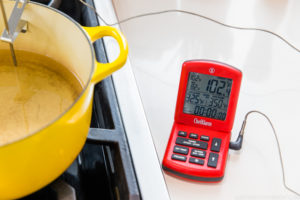

The picture below shows the dough doubled in size, after 75 minutes of proofing.

Prepare 1-2 Tbsp of all-purpose flour and put it at the corner of your work surface. Lightly flour the work surface and your hands.

Using the pastry card, remove the dough from the bowl and transfer to the lightly floured surface. Sprinkle some flour on top of the dough and press the dough down with your hands to release any air bubbles.
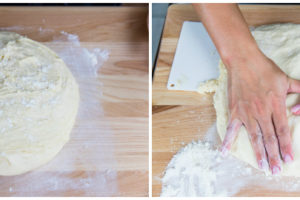

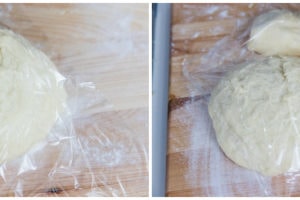
Each dough balls will make roughly 3 Pon de Ring donuts. Using the pastry card, cut the dough into small balls. Each ball size should be ½ – ¾ inches (1.5 cm) in length and width. Or if you have a digital kitchen scale, each ball should be 5 grams.

Roll the ball between your hands, but try not to spend too much time. Over-kneaded dough often ends up with hard crust and a dense, dry interior. Since the dough is very sticky, this pastry card is very helpful.
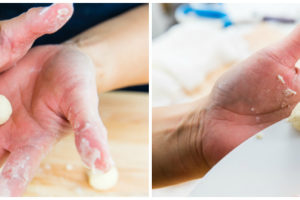



To make sure the balls won’t separate in the hot oil, use a pastry brush to dab water on the dough where balls attach to neighboring ones. Cover the donuts with a damp paper towel or light cloth (make sure it’s not heavy) and allow to rest for 15-20 minutes. Continue with the rest of the dough. If you are taking a very long time (especially first time), it’s very helpful if you work with a partner so the dough won’t be over-proofed.

When you’re finishing up with the last batch of dough, start heating the oil to 350 ºF (177 ºC). Prepare the first baking sheet lined with a paper towel and second baking sheet lined with a parchment paper and put a wire rack on top.
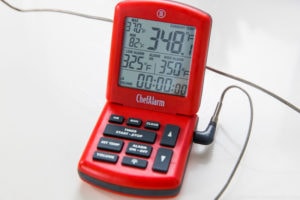

Let go of the donut and set the timer for 1 minute 15 seconds for the first side. Tip: Only add enough donuts for a 5-10 degree drop in temperature (I only add 2 donuts per batch). If the oil cools down too much, the donuts won’t fry properly.

When the 1 minute 15 seconds timer beeps, flip the donuts quickly using chopsticks or tongs. Fry the second side for 45 seconds.

When the 45-second timer beeps, scoop up the donut and drain well. Then transfer to the paper towel to drain excess oil. Repeat with remaining donuts, then turn off the heat.
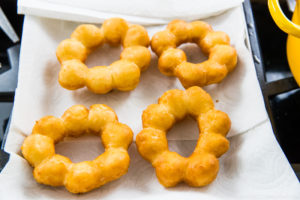

Place it onto the prepared rack to allow excess glaze drip down. The glaze will set and harden on the donuts after 30 minutes.


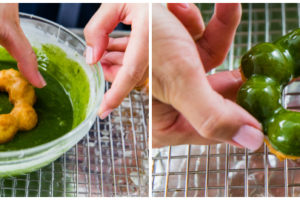
Just like any other deep-fried foods, it’s best to eat the donuts when they are warm. Enjoy!

Whole Milk: Use whole milk for best result. I do not recommend low fat or skim milk.
Tapioca Flour: ¼ cup Bob’s Red Mill Tapioca Flour is 30 g.
All-Purpose Flour: ¼ cup Bob’s Red Mill AP Flour is 34 g.
Oil: Avoid using vegetable oil (read my post). Please adjust the amount of oil based on how wide/tall your pot is. My Dutch oven is 3.5 QT and I used 1 QT (1000 ml, 4 cups) of Sufflower Oil. The Dutch oven is heavy and thick, and it conducts and retains heat very efficiently. The high sides also help prevent splatters during frying. What to do with leftover oil? Please read this post.
Helpful Tools: Stand mixer, pastry card, kitchen scale, thermometer, Dutch oven or heavy bottomed pot. Please read the post.
Recipe by Namiko Chen of Just One Cookbook. All images and content on this site are copyright protected. Please do not use my images without my permission. If you’d like to share this recipe on your site, please re-write the recipe and link to this post as the original source. Thank you.